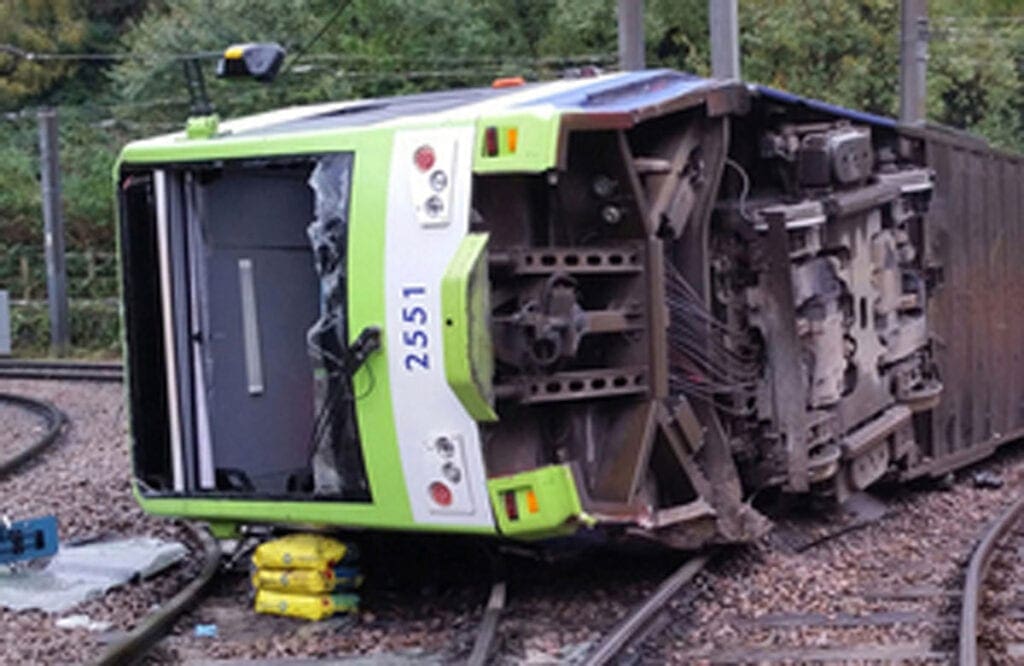
The families of Croydon tram crash victims have demanded a new inquest into their deaths after a jury concluded they died as a result of an accident and were not unlawfully killed.
Seven passengers died and a further 51 were injured when the tram derailed in south London on November 9 2016.
Dane Chinnery, 19, Philip Seary, 57, Dorota Rynkiewicz, 35, Robert Huxley, 63, and Philip Logan, 52, all from New Addington, and Donald Collett, 62, and Mark Smith, 35, both from Croydon, were killed in the crash.
Enjoy more Railways Illustrated Magazine reading every month.
Click here to subscribe & save.
On its 10th day of deliberations at Croydon Town Hall, the 10-person inquest jury reached a unanimous conclusion that their deaths were a result of an accident.
See also
- No ‘significant defects’ found in crashed Croydon tram, inquest hears
- RAIB inquest into 2016 Croydon tram crash opens
Several members of the victims’ families walked out of the room at Croydon Town Hall in tears after the decision was announced.
It can now be reported that south London senior coroner Sarah Ormond-Walshe refused to call a number of people who the victims’ families wanted to give evidence about alleged safety failings.
Those potential witnesses include senior managers of operator Tram Operations Ltd (TOL) – a subsidiary of FirstGroup – and Transport for London, plus other experts and tram drivers.
The victims’ families will now call on the Attorney General Michael Ellis QC to apply to the High Court to grant a new inquest. They will also seek to judicially review Ms Ormond-Walshe’s decision on which witnesses to call.
Mr Logan’s granddaughter, Danielle Wynne, told the PA news agency: “I’m so upset and angry.
“It’s not an accident. Someone is to blame.
“We want lessons to be learned so that no other family has to go through this.”
Mr Smith’s mother, Jean Smith, 64, said: “I am bitterly disappointed as justice has not been done today.
“It has been a total farce as we have only heard half of the evidence and no-one who could potentially have been responsible for the crash has been called as a witness.
“It’s morally wrong that we haven’t been able to hear from anybody from TfL (Transport for London), TOL, or the driver during the proceedings, whatever legal precedent says.
“It feels like they have been able to hide from giving evidence and it simply isn’t fair or just. Justice has been suffocated because of the coroner’s ruling.”
Ben Posford, partner and head of catastrophic injury at London law firm Osbornes Law, representing the families of five of the seven victims, said they are “understandably angry and upset”.
He went on: “Ultimately they feel that nobody has been held accountable for the tragic events almost five years ago and will keep fighting for justice for their loved ones.
“As a result, we will be pursuing the legal options open to us by calling on the Attorney General to apply to the High Court for a new inquest.
“The families will also be considering judicial review proceedings against the coroner, to get the answers they deserve.”
The jury’s foreman said it concluded that TOL had a risk assessment process which “failed to sufficiently identify the risk” of a tram overturning at the Sandilands curve, did not identify “additional measures to mitigate risk” and had a culture which “discouraged drivers from reporting health and safety concerns”.
Matthew Gregory, chief executive of FirstGroup, said: “Our thoughts remain with the families and loved ones of those who lost their lives, and all those who were injured or affected by this terrible event.”
He insisted the company has “an unwavering commitment to safety”.
New safety measures introduced with Transport for London following the crash include improved speed monitoring and restrictions, in-cab safety devices and enhanced roster planning, Mr Gregory said.
During the inquest, the jury heard the tram toppled over and spun off the tracks in darkness and heavy rain near the Sandilands stop after hitting a curve at 73kph (45mph). The speed limit for that stretch of track was 20kph (12mph).
All of the fatalities had been either fully or partially thrown out of the tram through the windows or doors when the glass shattered.
Rail Accident Investigation Branch (RAIB) chief inspector Simon French told the inquest that the driver, Alfred Dorris, may have slipped into a period of “microsleep” on the stretch of track ahead of the curve. He said extra signage could have mitigated the risk and there were apparent “culture issues” at TOL that meant drivers were unwilling to admit to speeding or other errors.
There was a previous incident just 10 days before the crash when a driver hit the same bend at 45kmh (27mph) and very nearly overturned, but the incident was insufficiently investigated, Mr French added.
Mr Dorris was excused from attending the inquest due to poor health.
The inquest was read evidence that an officer from the Metropolitan Police who was at the scene of the crash heard a man who he believed to be the driver say: “What have I done? I’ve killed them.”
During police interviews, Mr Dorris said he was “confused”, but when asked if he had fallen asleep he replied: “No, no, no.”
The families of those killed say he has never apologised for the crash.
He was arrested at the scene of the crash, but in October 2019 the Crown Prosecution Service announced he would not be charged with manslaughter due to a lack of evidence. The CPS also said the corporate manslaughter charges would not be brought against TfL or TOL.





